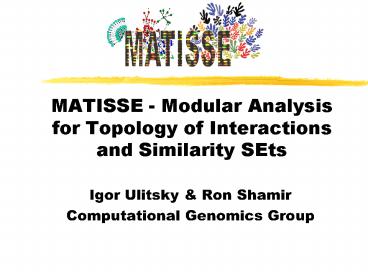MATISSE Modular Analysis for Topology of Interactions and Similarity SEts - PowerPoint PPT Presentation
1 / 16
Title:
MATISSE Modular Analysis for Topology of Interactions and Similarity SEts
Description:
MATISSE - Modular Analysis for Topology of Interactions and ... Microarray data analysis. Input: expression levels of (all) genes in ... network analysis ... – PowerPoint PPT presentation
Number of Views:60
Avg rating:3.0/5.0
Title: MATISSE Modular Analysis for Topology of Interactions and Similarity SEts
1
MATISSE - Modular Analysis for Topology of
Interactions and Similarity SEts
- Igor Ulitsky Ron Shamir
- Computational Genomics Group
2
Microarray data analysis
- Input expression levels of (all) genes in
several conditions - Analysis methods
- Clustering (CLICK)
- Biclustering (SAMBA)
- Extraction of regulatory networks
3
Protein interaction network analysis
- Input Network with nodesproteins/genes
edgesinteractions - Analysis methods
- Global properties
- Motif content analysis
- Complex extraction
- Cross-species comparison
4
Integrated analysis
- Combined support for low quality data
- Joint visualization
- Statistics of known pathways
- Detection of hot spots
5
MATISSE
- Identify sets of genes (modules) that
- Have highly correlated expression patterns
- Induce connected subgraphs in the interaction
network
Interaction
High Similarity
6
The Probabilistic Model
- Formulates module finding as a hypothesis testing
problem - The likelihood ratio is decomposed into pairwise
weights - Allows incorporation of gene-specific priors
- Parameters learned by an EM algorithm
7
Computational aspects
- Finding a single module without connectivity
constraints - Reduces to finding the heaviest subgraph (/-
edge weights) - An NP-Hard problem
- Heuristics inspired by maximum density
approximation algorithms
8
MATISSE workflow
- Seed generation
- Greedy optimization
- Significance filtering
9
Finding seeds
- Three seeding alternatives
- Building small seeds around single nodes
- Best neighbors
- All neighbors
- Approximating the heaviest subgraph
10
Greedy optimization
- Simultaneous optimization of all the seeds
- The following steps are considered
- Node addition
- Node removal
- Assignment change
- Module merge
11
Advantages of MATISSE
- No need for confidence estimation on individual
measurements - Works even when only a fraction of the genes have
expression patterns - Can handle any similarity data, not only
expression - Produces connected modules
- No need to specify the number of modules
12
Osmotic shock response of S. cerevisiae
- Network of 6,246 genes and 65,990 protein-protein
and protein-DNA interactions - 133 experimental conditions response of
perturbed strains to osmotic shock (ORourke and
Herskowitz, 2004) - 2,000 genes filtered based on variation criterion
13
GO and promoter analysis
14
Pheromone response subnetwork
Back
Front
15
Proteolysis subnetwork
16
Performance comparison
of modules
of modules with category enrichment at plt 10-3
17
Performance comparison (2)
of annotations
annotations w enrichment at plt10-3 in modules
18
Human cell cycle
- Constructed a network with 6,000 nodes, 25,000
edges - HPRD
- BIND
- Y2H studies
- SPIKE
- HeLa cell cycle time series (Whitfield 02)
- Produced subnetworks enriched with all the phases
of the cell cycle
19
M phase subnetwork
20
Adjustment for case-control studies
- Drawbacks of current methodology
- focus on similarity across all conditions
(Pearson correlation) - Case-control studies require a focus on genes
differentially expressed between classes
(healthy/sick or cancer subtypes) - Next version of MATISSE will have capabilities to
handle such data
21
Prostate cancer preliminary results
22
MATISSE tool capabilities
- MATISSE algorithm execution
- Dynamic subnetwork layout
- Customized node/edge highlighting
- Dynamic expression matrix viewer
- Module annotation
- TANGO
- Annotations with custom datasets
- PRIMA
- Calculation of different coefficients based on
network/expression

